The State of the Union address is an annual ritual with familiar rhythms. President Trump, who revels in the pomp and circumstance of this annual celebration of our democracy, did not deviate from this template. He surprised no one when he declared that the state of our union is strong. His speech was complete with a recitation of his administration’s accomplishments, calls to put country above party and compromise for the common good, and inspiring stories from courageous Americans. The key question is whether an historically divisive president can credibly champion the cause of national unity, and whether a president who has rejected compromise to maintain the unswerving loyalty of his base will be able to find common ground with an opposition he has kept at arms’ length.
This year’s edition was different in some important ways. For the first time since the Challenger space shuttle disaster in 1986, the speech was postponed. For the first time ever, a political controversy sparked the postponement. Partisan polarization is at its highest level in decades, and as my Brookings colleague Elaine Kamarck has shown, the Trump presidency is at a very low ebb. And if, as the president declared, legislative progress is incompatible with “ridiculous investigations,” he is facing a year of stalemate.
As President Trump entered the House of Representatives this evening, he had a number of questions to answer. Would he mention the legal troubles clouding his administration? How would he deal with the issue at the heart of the record 35-day government shutdown, his demand for $5.7 billion from the taxpayers to fund a wall on our southern border? What substance would he provide for the “unity” theme his advisers had foreshadowed? Would he choose this moment to please his evangelical supporters by intervening in the roiling debate about late-term abortion? Would there be any surprise announcements, such as a declaration of national emergency to jumpstart construction of the southern wall? And in what ways would the tone and substance of the speech set the stage for his reelection campaign?
Here, in brief, are the answers the speech provided.
The wall. The president gave no ground on his signature issue. Citing crime, drugs, and human trafficking, he invoked the threat at our “very dangerous” southern border and warned that Mexico was preparing to bus Central American immigrants to poorly defended portions of this border. He drove a wedge between the “working class” and the “political class.” Although he did not invoke his emergency powers, he made no new offer to break the legislative standoff, and his tone was anything but unifying.
Abortion. Describing recent controversies in New York and Virginia in lurid language, President Trump said that he would introduce legislation to prohibit late-term abortion.
The unity agenda. While providing few details, the president promised to work with Congress on infrastructure investment and cost reductions for prescription drugs, two issues that enjoy broad bipartisan support. He called for new programs to eradicate the transmission of AIDS and fight childhood cancer. And he announced that his budget would include support—how much was not clear—for paid family leave.
Political strategy. President Trump has noticed that he is doing badly among women and minority groups, and he tried to reach out to them. He talked at length about criminal justice reform and introduced some of its beneficiaries. He noted that a century after the start of female suffrage, Congress now contains a record number or women, to the obvious delight and bemusement of the large group of newly elected Democratic women wearing white. At the same time, he signaled his intention to use immigration, trade, abortion, and defense to secure his base of working class and white evangelical voters. In what was the clearest message to his base he said, “No issue better illustrates the divide between America’s WORKING CLASS and America’s POLITICAL CLASS than illegal immigration. Wealthy politicians and donors push for open borders while living their lives behind walls and gates and guards.”
Appealing to economic conservatives, he denounced Democrats’ move toward “socialism” as incompatible with America’s tradition of freedom. America will never be a socialist country, he declared.
Over the past 40 years, State of the Union addresses haven’t had much of an effect on public attitudes about presidents. During this period, on average, presidential approval ratings rose 0.2 percent after the speech.
This average conceals some sizeable swings. In the aftermath of the 1998 State of the Union, delivered when Bill Clinton was facing impeachment, his approval rating rose by 10 points. At the other end of the continuum, George H. W. Bush’s 1990 State of the Union address reduced his public approval by 7 points.
It is possible that something has changed in recent years. Since 2012, 5 out of 6 State of the Union addresses have led to gains in presidential approval averaging 1.7 points. President Trump’s first State of the Union in 2018 was consistent with this trend, netting him a gain of 2 points in public opinion. It will be interesting to see how the 2019 edition measures up against this baseline.
In the long run, the key questions are whether President Trump’s modest unity agenda will be enough to lower the partisan temperature in Washington, and whether the president is willing to make compromises on more divisive issues. The substance and tone of tonight’s speech do not suggest affirmative answers. It won’t take many legislative fights, combative tweets, or congressional investigations to nullify the effects of his speech and plunge the country back into what has been business as usual for this presidency.
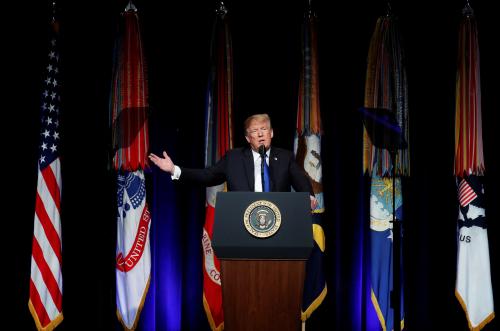
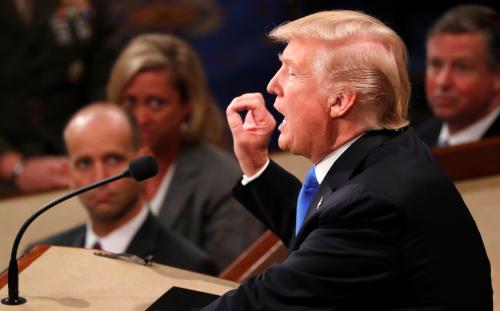
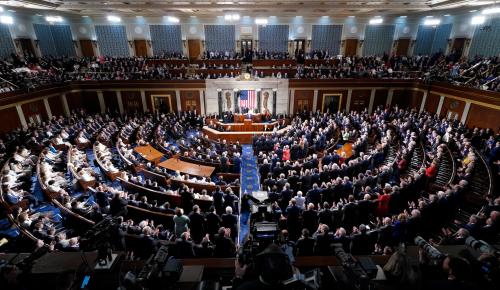


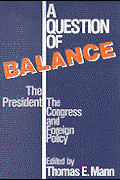



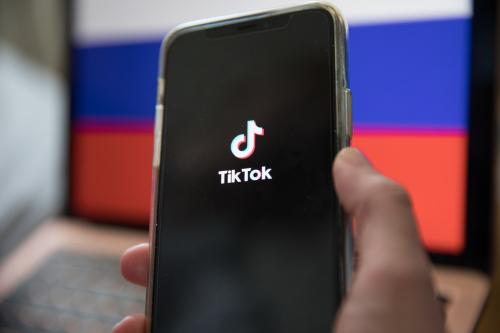
Commentary
Will Trump’s call for unity in the State of the Union last?
February 5, 2019